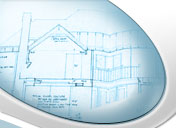| 
Whole House Audio
I was at a friend’s house a few years ago and witnessed a terrific B&O multi-room audio system. For those who don’t know, these systems usually hide all the audio gubbins away in a closet somewhere, the only evidence being discrete loudspeakers embedded in the walls and ceiling and a stylish control plate by the light switch where you could select your favourite CD from a juke box type setup.
Things have moved on a little since then and the vogue now is to use a “music server”. This is basically a computer server with a large hard disk that stores music files, usually in MP3 format like an IPOD and, in some high end systems, uncompressed straight from the CD. The server will feed music to a converter and amplifier either in the room where the speakers are or in some sort of central box with long wires going off to the room speakers.
There are a number of advantages with systems like this. Most if not all of them can feed multiple zones simultaneously with different music. So for instance, David Gray in the Kitchen, Mozart in the lounge, Zero 7 in the bathroom and Mega Death in the teenage bedroom all at the same time. Various tracks from the CDs copied onto the server can be assembled into play lists that can simply be set off and left alone. Play lists can be compiled for individual’s tastes or to suit an event such as a dinner party. Some of the more sophisticated systems will go off to the internet and automatically download title and tack details of any CD you load on the server to save you typing anything in.
This technology is still quite new, and apart from MP3, there are not too many standards yet. This means that most systems are proprietary and need all the components (including cables) from the same manufacturer. Installation is often a specialized task too, with dealers not willing to sell the kit without doing the install as well. This all means that it is very expensive indeed. For one high end system I was quoted £4,000 for the music server alone - without amplifiers, speakers, controllers or installation. Not only is that way beyond my budget, I am not willing to be locked into proprietary technology.
I did some research and found a number of network-connected MP3 streaming devices from companies like Turtle Beach and SlimP, but I settled on the Exstreamer from Barix. This is a neat little box that connects either wirelessly or wired to a TCP/IP network and talks to a server. The great thing about this box is that it runs a mini web server inside which you can connect to from a PC or IPAQ or the like. From the web interface you can select tracks or play lists, pause and fast forward music and configure the device. On the server you load up tracks from your CDs through Musicmatch or similar and run a little Java based programme and off you go. The Exstreamer has a very neat little feature that makes is speak its IP address when you turn it on – no more guessing games. I know that Barix are developing a software upgrade that will eliminate the need for any server-side special software too – this upgrade will also provide the capability to stream internet radio broadcasts.
So I went on eBay and brought an old Compaq Proliant server with 1Gb of memory, 2 x 550 Mhz P3 processors and loads of storage. I also brought a 19” cabinet and an Ethernet switch. I linked this with my wireless network and the Exstreamer to my hi-fi, and it worked straight away. The complete setup cost about £700 – obviously you only need one server but for each room there is the need for an Exstreamer, speakers and amplification of some sort, either an existing hi-fi system or an in-wall or central “rack mounted” amplifier. Barix do an amplified version of the Exstreamer but it is only 10watts per channel, which may not be punchy enough for some installations, what is good is that you can adjust volume, treble and bass from the web interface, which eliminates the need for a separate hi-fi system and infra-red remote control.
My vision for the audio system is to eliminate any electronics from the rooms and centralise everything in a cabinet in the basement. Speakers embedded in the walls or ceiling will be the only indication of the system, and control will be achieved through a web interface on a wireless IPAQ, web pad or similar device. The speakers would be cabled back (ideally CAT5 for consistency) to the cabinet where all the amplification and other components reside. I am told this is better than sending “line level” signals throughout the house to remote amplifiers as it is more susceptible to interference from mains or other cabling. From this system you will be able to select music, internet and digital radio sources and any video or TV piped to the room would use these speakers too.
Video Distribution
Video distribution is more challenging than audio, as the bandwidth and nature of signal is very different and usually requires coaxial cable. This would typically limit the flexibility of video distribution unless you ran coax to every outlet that you ran CAT5 to. This would be expensive, cumbersome and defeats the object somewhat of standard, structured cabling.
The challenge therefore is to encode video signals so that they can be delivered via a CAT5 cable, and decoded at the other end into a SCART, S-Video or whatever signal into a TV or monitor. This way you can patch video to any CAT5 outlet anywhere in the house. There is a system called Sourcerer, which I get the feeling, is aimed at the commercial and broadcast market and it is pretty expensive. Another system called Nexus also looks good and seems good value too. The main limitation of both of these systems is that control is provided via infra-red. This, on the surface sounds good in that if you have a DVD player or Tivo tucked away in a wiring closet somewhere, you can use its remote control in the viewing room and the signals would be passed across the CAT5 cable by Nexus or Sourcerer and relayed via an IR blaster to the appropriate equipment. My concern with this is that it still requires the source equipment remote control (or an all-in-one or Pronto) and that you suffer the usual limitations of IR of range and direction restriction. My vision for controlling video is the same as whole-house audio. I would like to have an wireless network connected IPAQ, web pad or similar where you select the room you want to access, and up pops the means of controlling lighting, heating, audio, video and whatever else you want. Once you have told the IPAQ what room (and therefore tv or screen you want to use), you should be able to select what source you want to view, for example a movie copied from DVD onto a hard disk server, a DVD from a jukebox, Tivo, Sky+, live terrestrial TV, free to air satellite, Sky Digital, cable etc. Where sources are assigned to other screens, you would have the option to view this also, or select a new source. Turning off the screen from the IPAQ would automatically release the source that was assigned to it.
In the equipment rack, for say, 8 screens, they could share 3 free to air digital boxes, 3 terrestrial tuners a Tivo and Sky digital box. Along with DVD and hard disk server should provide enough choice and variety (although the hard disk server is capable of serving multiple sources simultaneously). Sound for the various sources would route through the whole house audio.
The system that seems most likely to achieve this without costing the earth is called Kat5. This is run by a very smart guy called Keith Doxey who has a point to point solution on the market already but is working on a centralised switch version. The thing I like about it is that it is controllable through software and therefore does not need IR (although it is capable of IR control too). The various video sources are obviously controlled by IR, but I can translate the commands from the IPAQ into the appropriate IR signals in the server and pass them on to the devices via an IR blaster. Arguably I could do the same with the switch, however, I have no doubt that the next generation of video devices like tuners and DVDs will be IP addressable and software controllable like hard disk media servers are already. The big fly in the ointment is the fact that Keith Doxey is a one man band, trying to hold down a full-time job and a young family as well as his Kat5 enterprise, this means the date when the centralised switch will be ready is anyone’s guess. Fortunately I do not need it soon, and any solution I ultimately choose will use CAT5 as the cabling media so this won’t hold me back on the build!
| |


